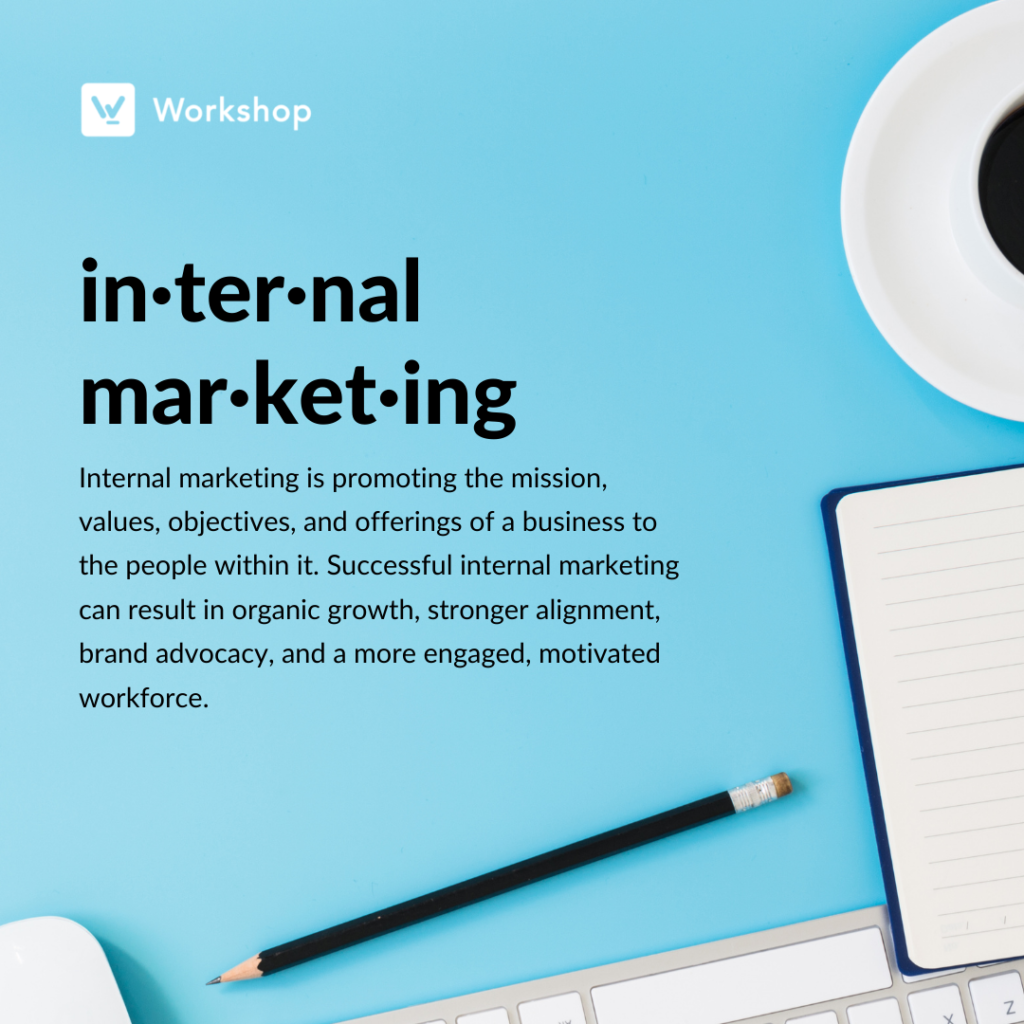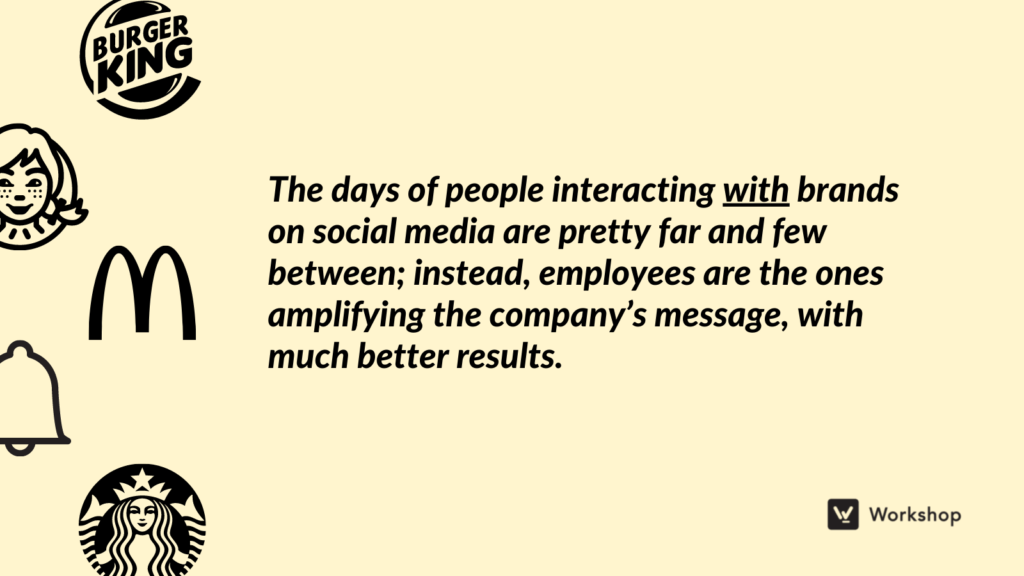What is internal marketing?

If you’re looking to scale the success of your marketing initiatives (for free), then it’s time to step away from the SEO research and look inward!
Companies need to start allocating more time, energy, and resources to internal marketing — a strategy that is seriously overlooked in almost every business, and deserves all the same intention and effort as external marketing.
What is internal marketing?
The definition of internal marketing is the promotion of the mission, values, objectives, brand, and offerings of a company to the people within it.

There are all kinds of programs, initiatives, and events that can fall into this category: the company newsletter, all-hands meetings, quarterly retreats, internal product launches, celebrations, memos, OKRs, videos, ERGs, big announcements, new hires, campaign launches, team meetings, presentations, employees’ social media posts…and believe me, I could go on.
Ultimately, though, it’s obvious to all marketers that the lines between internal and external marketing are becoming blurrier and blurrier by the tweet.
Just take a look at all of the trends that naturally feed into a robust internal marketing strategy, like employer branding, thought leadership, and brand advocacy. At large-scale organizations, we’ve even seen everything from massive employee conferences to internal podcasts. (In many ways, it’s the natural evolution of all marketing and communications: you may start with a little text-based newsletter, but over time, those materials can and often should become fully branded experiences.)
When internal marketing is done well, it can play a huge role in growing the company and scaling the culture. When it’s done poorly, it can result in everything from small miscommunications to a catastrophic hit to the company’s integrity (not to be overly dramatic…but we’ve all seen examples of this play out in public/on Twitter).
The benefits of doubling down on internal marketing
There are *so* many reasons why investing in internal marketing makes sense, but I’ll speak straight to the executives first: low (almost no) cost, HUUUUUGE ROI. Other than the time and effort it takes to build up these campaigns, and perhaps the purchase of a tool or two to help you scale it, internal marketing is a COMPLETELY FREE channel and comes with guaranteed results.

Here are a few of the benefits of internal marketing:
Organic growth through employee advocacy
When you put an emphasis on internal marketing, your employees will naturally start to share that work via social media…and suddenly, your brand, your product, and your company are in front of a huge new audience without any additional monetary investment on your part. One study suggests that when a brand is consistently presented, you can expect to see a 33% increase in overall growth. Research also shows that companies with formal employee advocacy/internal marketing programs have shorter sales cycles and find it easier to attract (and keep) new business.
Every single one of your employees has the potential to become a spokesperson and advocate for the brand. I’ve seen huge organic reach from a well-run internal conference, and I’ve seen customers clamor over employee-only t-shirt designs. I’ve seen employees talk openly about our ERG efforts on Twitter, and salespeople create mini-demos of new product features on LinkedIn. We’ve had engineering leaders speak at massive conferences, and graphic designers interviewed for top-tier publications. All of these opportunities came from consistent internal and external communications, and making sure a portion of our time could be allotted to internal marketing initiatives.
There’s no place that exemplifies this more than social media. The days of people interacting with brands are pretty far and few between; instead, employees are the ones amplifying the company’s message, with much better results:
- Brand messages reached 561% further when shared by employees vs the same messages shared via official brand social channels
- Leads developed through employee social marketing convert 7x more frequently than other leads.
- Content shared by employees receives 8x more engagement than content shared by brand channels

This also explains the prevalence of thought leadership on LinkedIn & Twitter. 😉
Stronger alignment (and results!) across teams
Internal marketing is the best way to align individuals and departments across the company. A thoughtful campaign can help reiterate the company’s values, frame the importance of a particular problem, drive momentum towards an objective, or educate the organization about a new solution. As your company scales, this becomes more and more important; you want to keep everyone headed in the same direction.
Prioritizing internal marketing also opens up an entire world of collaboration and opportunities for departments to work together. How many times has the sales team or support team “not known” about a new marketing campaign? How often have you had to chase down great customer service stories to share or create case studies? How often does an employee miss the eighteen emails your HR team sent about open enrollment dates? Building out your internal marketing strategy can bring out great ideas before a launch, and create feedback loops to give you a pulse on what’s working (or not working) within the organization.
Once your initiative is fully formed, internal marketing also happens to be the best way to get in front of (and convince) key stakeholders. If you’re looking to create change within a company, your external success depends on getting everyone internally on board and excited about your plan. We’re not alone in this; 100% of respondents in a recent survey believe that internal communications will become more valued in the boardroom during the next decade.

Better employee engagement
Having a clear, well-communicated strategy and set of objectives for the next year or two will also help employees feel secure and optimistic. They’ll be on the same page with company leadership, and it will reinforce how their work ties into the greater purpose of the organization.
73% of employees are more engaged when they believe they work for a purpose-driven company. A business that emphasizes its mission clearly and often is the key to creating that purpose-driven environment.
Not only that, but great internal marketing initiatives also provide room for employee response and participation. Some communication platforms (like Workshop) offer two-way conversations, so leaders can share key messages, and employees can comment and thread feedback.
Consistent messaging
It’s impossible for an employee in a large organization to know everything the company is doing, but it’s important to keep everyone well-informed and on message. While your executive team may drive the overall business strategy and serve as the public face of the organization, the rest of your employees are the ones who are having one-on-one conversations with customers and prospects. These employees need to hear about your new products, acquisitions, or issues first, before they find out about it on the 6 o’clock news or in your latest Facebook ad.

This can also have a couple of other major benefits: (1) it means your teams have more time to get familiar with the offering, and (2) you can see if your messaging results in great adoption or reactions, internally.
To truly sell and market your company’s products, your employees need to know them inside and out. They should know what makes your products and your brand unique. Unfortunately, your company’s current efforts around internal product marketing likely aren’t working; HBR found that while tactics like product training and email are some of the most widely used to educate employees (85% and 91%, respectively), they often fail to drive consistent messaging about the product. This is largely because the majority of businesses (69%) rely on bloated information dumps, like document libraries and shared folders that house outdated information, to prepare frontline teams.
Carving off time for intentional, internally-focused product marketing (and creating great feedback loops for those initiatives) can help drive much better alignment and create better customer outcomes.
Why are marketing departments not prioritizing internal marketing?
Internal marketing and communications often winds up shoved into one of two org charts:
- It lives in a kind of no man’s land between departments (typically HR and marketing). One might own it, and be advised to use the other as a strategic partner.
- It lives in a completely separate communications department.

Colin Mitchell’s epic HBR article, “Selling the Brand Inside,” is one of the most-referenced resources about internal marketing, branding, and communications…and it was written in 2002! Twenty years later, we have yet to widely adopt his ideas…but I’m here to reinforce them. 🙂
In the essay, he argues that marketers should take personal responsibility for this role, because:
“The people who are charged with internal communications—HR professionals, typically—don’t have the marketing skills to communicate successfully. Information is doled out to employees in the form of memos, newsletters, and so forth, but it’s not designed to convince them of the uniqueness of the company’s brand.”
I have to agree: while great internal communications will always require cross-departmental effort, the marketing team is uniquely situated (and has the skillset) to persuade everybody to be on the same page, and to build a consistent brand experience internally and externally. They know how to navigate messaging, get it to a targeted audience, track the right success metrics, and build engaging creative to go alongside it. (And, of course, they often have the right tool to do it!)
At the end of the day, marketing execs are likely overlooking internal marketing for one major reason: it’s simply not aligned to their current goals, or they feel like it is someone else’s responsibility. Most are focused on revenue and/or the product, and just haven’t made it a priority, but they still tend to get pulled into all of these initiatives regardless.
If your internal marketing and communications efforts are volleying back and forth between marketing and HR, then take it as your responsibility! It’s a huge opportunity and will help you organically scale your current external marketing efforts.
If you have a separate communications department — or if HR owns internal comms, and you don’t see that changing anytime soon — reach out and form a robust partnership with them. Ensure they have the creative and strategic resources they need to do this job really, really well; and if it makes sense, consider advocating that they become a formal part of the marketing org.
If that isn’t an option, and your comms and marketing teams will continue to report to different directors, find other ways to create natural alignment. Can the teams sit close together? Can you invite a member of the other department to monthly meetings? Do you have the right digital channels to collaborate on? Do you have a shared process for publishing internal and external news? Are you working towards the same business goals?
Getting started with internal marketing
If you’re at a company with 200+ employees, it’s time (and maybe even a little late!) to start prioritizing internal marketing.
All in all, there really is little to no budget required for internal marketing. You likely already have most of the communication tools you need, from email and social media to Zoom and Slack. You may benefit from adding a tool to help with targeting specific lists (because not every announcement needs to go to every employee), sending communications across multiple channels, and measuring analytics — we can help with that! And because communications takes time and talent, you may also want to look at adding an internally focused staff member to your marketing team. But considering the cost-benefit of every other acquisition channel…it’s a pretty sweet deal.
Sure, you can sit down and put together a super robust marketing strategy doc…but if you aren’t ready to march into the CEO’s office and/or demand a full-time hire, I encourage you to try it with one campaign. Align it with your company (or department’s) current goals or struggles, and choose the internal channels that suit your message best…or, choose one internal channel and give it the full-scale marketing treatment.
Trust me: you will be genuinely surprised and delighted at how much your internal marketing efforts will amplify your external ones.
The next step
If you’re looking for internal marketing software to help you scale these efforts quickly and effectively, take a look at Workshop! And here’s a slightly longer list of the only four internal communication and marketing tools you need to deliver on all of the above.







